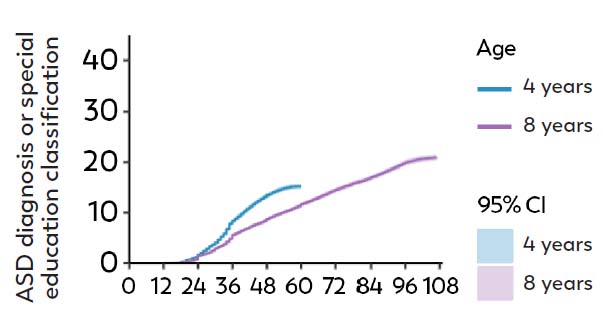Spotlight On Progress in Evaluation and Diagnosis of Autism Spectrum Disorder among 4-year-old children
Pages in this Report
- 2023 Community Report on Autism
- Executive Summary
- Key Findings from the ADDM Network
- A Deeper Dive
- Spotlight On: Progress in Early Identification Disrupted during the COVID-19 Pandemic
- Spotlight On: A New Pattern in Racial and Ethnic Differences
- Data for Action
- ADDM Network Site Snapshots Overview
- A Snapshot of Autism Spectrum Disorder in Arizona
- A Snapshot of Autism Spectrum Disorder in Arkansas
- A Snapshot of Autism Spectrum Disorder in California
- A Snapshot of Autism Spectrum Disorder in Georgia
- A Snapshot of Autism Spectrum Disorder in Maryland
- A Snapshot of Autism Spectrum Disorder in Minnesota
- A Snapshot of Autism Spectrum Disorder in Missouri
- A Snapshot of Autism Spectrum Disorder in New Jersey
- A Snapshot of Autism Spectrum Disorder in Tennessee
- A Snapshot of Autism Spectrum Disorder in Utah
- A Snapshot of Autism Spectrum Disorder in Wisconsin
- Glossary
- References
Download and print this page [PDF – 485 KB]

Knowing how many children have ASD is just part of the picture. Understanding more about the characteristics of children with ASD, such as age of diagnosis, is also important.
Monitoring, screening, evaluating, and diagnosing children with ASD as early as possible are important steps to make sure that children receive the services and supports they need to reach their full potential.
The latest report from the ADDM Network provides critical information on progress made toward early identification of children with ASD and informs providers—particularly public schools—of future service needs.
Tracking ASD among 4-year-old children
Tracking ASD among 4-year-old children increases our understanding of the characteristics and progress in the early identification of younger children with ASD. Early identification can help families get early access to services in their communities.
In 2010, CDC began monitoring ASD among 4-year-old children living in a subset of communities participating in the broader ADDM Network. For the first time in 2018, surveillance among 4-year-old children expanded to all 11 sites participating in the ADDM Network.
Key findings from the ADDM Network
More children are being identified with ASD at an earlier age
Children born in 2014 (4-year-olds) were 1.5 times as likely as children born in 2010 (8-year-olds) to be identified as having ASD by 48 months of age. This means more children are being identified as having ASD by 4 years of age now than before.
These findings are consistent with previous reports and may indicate greater awareness of ASD among families, healthcare providers, and educators to evaluate and identify children early.
More children are being identified with ASD by 48 months

Racial and economic disparities are different from previous reports
Among 4-year-old children, new patterns were found in the identification of ASD by race and median household income compared to previous ADDM Network data:
- More Black, Hispanic, and Asian or Pacific Islander children were identified with ASD compared to White children; and
- Children living in lower income neighborhoods had a higher rate of ASD identification compared to children living in higher income neighborhoods.
These findings may suggest improvements in ASD awareness, identification, and access to services in communities serving Black, Hispanic, and Asian or Pacific Islander children, and children living in lower income neighborhoods. Continued efforts are needed to ensure that all children with ASD are identified early and connected to the services they need as soon as possible.

- Developmental monitoring (also known as tracking or surveillance) is important for all children. Caregivers, such as parents, healthcare providers, and early educators, can learn how to look for developmental milestones—how children grow, move, communicate, interact, learn, and play. This information helps caregivers know what to expect at different ages, get ideas on how to promote positive development, and recognize potential concerns about development as early as possible. Developmental monitoring is an ongoing process, and CDC’s Learn the Signs. Act Early. program has tools and information to help at www.cdc.gov/ActEarly.
- A developmental screen is a short test using a validated screening tool to identify whether a child is learning basic skills, and it can help determine if there might be a delay. The American Academy of Pediatrics recommends screening children for ASD at 18 and 24 months of age.
- A comprehensive developmental evaluation is a thorough review of how a child plays, learns, communicates, acts, and moves, and whether those characteristics have changed over time. Various professionals can conduct developmental evaluations, including teachers, social workers, nurses, psychologists, doctors, and speech-language pathologists. This evaluation can include clinical observation, parental reports of developmental and health histories, psychological testing, and speech and language assessments. A comprehensive developmental evaluation is often a key step in getting services, including those through the school system.
- Diagnosis occurs when a developmental pediatrician, child neurologist, child psychiatrist, or child psychologist uses the results of the comprehensive evaluation to determine whether a child has ASD. Neurological and genetic testing can often exclude other disorders and can check for genetic and neurological problems that sometimes occur along with ASD. A medical diagnosis can be a key step in getting medical services provided through health insurance.